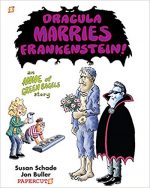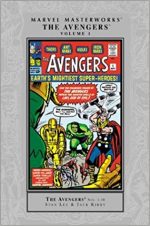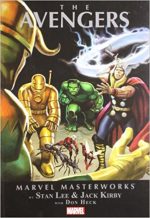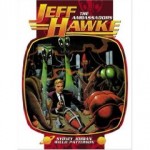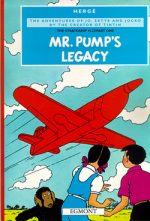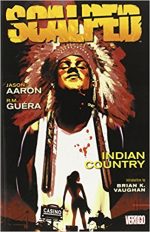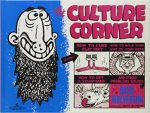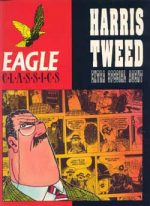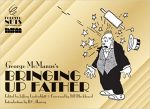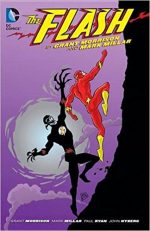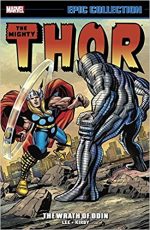
By Stan Lee, Jack Kirby, Vince Colletta & various (Marvel)
ISBN: 978-1-3029-0379-4
The Mighty Thor was the title in which Jack Kirby’s restless fascination with Cosmic Phenomena and Man’s place and role in the universe was honed and refined through his most dazzling graphics and captivating concepts.
The King’s career-defining string of power-packed signature pantheons all stemmed from a modest little fantasy/monster title called Journey into Mystery where – in the summer of 1962 – a tried-and-true comicbook concept (feeble mortal transformed into god-like hero) was revived by fledgling Marvel Comics to add an iconic Superman analogue to their growing roster of costumed adventurers.
However, whereas the rapidly proliferating Marvel Universe grew ever more interconnected as it matured with assorted superheroes literally tripping over each other as they contiguously and continually saved the world from their New York City bases, the mythic heritage of Thor and the soaring imagination of Kirby increasingly pulled the Thunder God away from mortal realms into stunning new landscapes.
Admittedly, the Son of Odin would pop back to Earth for an adventure or two, but it is clear that – for Kirby – Earth was just a nice place to visit whilst the stars and beyond were the right and proper domain of the Asgardians and their foes…
Crafted entirely by Stan Lee, Jack Kirby & Vince Colletta, this bombastic full-colour paperback tome – also available in eFormats – sees those fascinations culminating in a consciousness-expanding run of Asgardian exploits (spanning Thor #131-153 and covering August 1966 to June 1967) which changes forever the scope and power of comics storytelling…
For those who came in late: Once upon a time lonely, lamed American doctor Donald Blake vacationed in Norway only to encounter the vanguard of an alien invasion. Trapped in a cave, Blake found a gnarled old walking stick, which when struck against the ground turned him into the Norse God of Thunder!
Within moments he was defending the weak and smiting the wicked. As months swiftly passed, rapacious extraterrestrials, Commie dictators, costumed crazies and cheap thugs gradually gave way to a vast panoply of fantastic worlds and incredible, mythic menaces.
Soon, the magnificent warrior’s ever-expanding world of Asgard was a regular feature and mesmerising milieu for the hero’s earlier adventures, heralding a fresh era of cosmic fantasy to run beside the company’s signature superhero sagas.
Thus, every issue also carried a spectacular back-up series that grew to be a solid fan-favourite. Tales of Asgard – Home of the Mighty Norse Gods gave Kirby space to indulge his fascination with legends by providing initially complete vignettes and ultimately lengthy serialised epics – in every sense of the word.
Initially adapted myths, these little yarns grew into sagas unique to the Marvel universe where Kirby built his own cosmos and mythology, underpinning the company’s entire continuity.
This titanic tome commences with the Thunderer and Olympian rival Hercules returning triumphant from war in the underworld. Thor then secures a pledge from his terrifyingly inconsistent father Odin that he may wed his mortal love Jane Foster.
Hurtling back to Earth however, Thor finds his beloved long gone and her erstwhile roommate Tana Nile exposed as a superpowered Rigellian Colonizer who has just taken possession of Earth. ‘They Strike from Space!’ was merely prologue for a fantastic voyage to the depths of space and a unique universal threat…
At the end of the previous volume Tales of Asgard saw a band of assembled Asgardians face the horde of all-conquering Harokin as another multi-chaptered classic began, with young Thor impersonating the dynamic reiver. Here, the saga resumes with the hero exposed even as colossal companion Volstagg steals the enemy’s apocalyptic wizard-weapon ‘The Warlock’s Eye!’…
Issue #132 sees the Thunderer explosively laying down the law on ‘Rigel: Where Gods May Fear to Tread!’ and single-handedly liberating Earth. At the back of the comic ‘The Dark Horse of Death!’ arrives in the Tales of Asgard segment, looking for its next doomed rider…
The following issue is a certified Kirby Classic, as ‘Behold… the Living Planet!’ introducing the malevolent Ego, a sentient world and master of a living Bio-verse: a stunning visual tour de force that tiled one High Concept after another upon Thor, his new artificial pal Recorder and the reeling readership, whilst Harokin’s tale ended in one last ride to ‘Valhalla!’
The threat of invasion over, Thor returns to Earth to search for Jane, and after diligent efforts finds her with ‘The People Breeders!’ – a hidden Balkan enclave wherein pioneering geneticist The High Evolutionary was instantly evolving animals into men. His latest experiment had created a lupine future-nightmare – ‘The Maddening Menace of the Super-Beast!’ so it’s just as well the Thunder God was on hand.
Back in Asgard and an undefinable time agone, ‘When Speaks the Dragon!’ and ‘The Fiery Breath of Fafnir!’ pitted Thor and his Warriors Three comrades Fandral, Hogun and Volstagg against a staggering reptilian monstrosity: a threat finally quashed in #136’s ‘There Shall Come a Miracle!’
The lead story in that issue is a turning point in the history of the Storm Lord. ‘To Become an Immortal!’ finds Odin transforming Jane Foster into an Asgardian goddess and relocating her to Asgard, but her frail human mind cannot cope with the wonders and perils of the Realm Eternal and she is mercifully restored to mortality and all but written out of the series.
Luckily for the despondent Thunder God the beauteous warrior-maiden Sif was on hand…
With this story Thor’s closest link to Earth was neatly severed: from now on his adventures on Midgard are as a tourist or beneficent guest, not a resident. Asgard and infinity were now his true home, a situation quickly proved by the bombastic clash ‘If Asgard Falls…’
Set in the Gleaming City during the annual Tourney of Heroes (and originally published in The Mighty Thor Annual #2, 1966) this a martial spectacular of outlandish armours and exotic weaponry that turns decidedly serious when the deadly Destroyer is unleashed amidst the wildly warring warriors…
Although Thor had lost his human paramour, he rediscovered his childhood sweetheart, now all grown up and a fierce warrior maid to boot. A good thing too, since ‘The Thunder God and the Troll!’ (#137) introduces the bestial menace of super-troll Ulik and features open warfare begin between the Asgardians and their implacable monstrous foes.
During the spectacular carnage and combat Sif is captured and the Thunderer rushes to Earth to rescue her, whilst legions of monstrous subterranean troglodytes attacked the very heart of the kingdom…
The Tales of Asgard feature was gradually wrapping up, but still offered Kirby a place to stretch his creative muscles. ‘The Tragedy of Hogun!’ offers revelations concerning the gripping history of the dour warrior in an Arabian Nights pastiche which also introduces sinister sorcerer Mogul of the Mystic Mountain.
In ‘The Flames of Battle!’ Thor is reunited with Sif but deprived of his magical mallet Mjolnir, courtesy of exotic technology the trolls have mysteriously developed. Do the malign invaders have a potent new ally or a terrifyingly powerful slave?
Trapped on Earth, the hammerless Thor has no means of returning to the realm beyond the Rainbow Bridge whilst in Asgard, the war goes badly and the heroic gods are close to final defeat…
For the Tales of Asgard segments, ‘The Quest for the Mystic Mountain!’ finds Hogun and his comrades edging closer to victory and vengeance, culminating in a truly stunning Kirby spectacle in Thor #139 as the wandering warriors discover ‘The Secret of the Mystic Mountain!’ In the lead story of that issue, ‘To Die Like a God!’ wraps up the Troll War in eye-popping style as Thor and Sif invade the bowels of the Earth to save the day for humanity and Asgardians alike…
With #140 the extended epics are replaced by a short run of compete, single episode tales heavy on action, starting with ‘The Growing Man!’ as Thor heads back to Earth and discovers New York under attack by a synthetic warrior who grows larger and stronger with every blow struck against him.
Time-travelling marauder Kang the Conqueror is behind the Brobdingnagian brute, whilst in back-up ‘The Battle Begins!’, Hogun and Co are menaced by a terrifying genie…
In #141 Thor confronts ‘The Wrath of Replicus’, a bombastic, bludgeoning epic involving gangsters, aliens and super-robots, counter-pointed by stunning fantasy as the wandering Asgardian warriors meet ‘Alibar and the Forty Demons!’
‘The Scourge of the Super Skrull!’ then pits Thunderer against an alien with all the powers of the Fantastic Four, even as in Asgard a new menace is investigated by Sif and indomitable warrior Balder the Brave. The back-up tale finds Kirby’s seamless melange of myth and legend leap into overdrive as ‘We, Who are About to Die…!’ depicts young Thor and the Warriors Three facing all the mystic menaces of Mogul.
Thor #143 returned to extended epics with ‘…And, Soon Shall Come: the Enchanters!’ (inked by the magnificent Bill Everett) as Sif and Balder meet a deadly trio of wizards plotting to overthrow All-Father Odin, only to fall prey to their power. Escaping to Earth they link up with Thor, but they have been followed…
Everett also inked the Tales of Asgard instalment ‘To the Death!’ as comic relief Volstagg takes centre-stage to seduce Mogul’s sinister sister…
Colletta returned with ‘This Battleground Earth!’, wherein two Enchanters attack the warriors on Midgard whilst the third duelled directly with Odin in the home of the gods. At the back, Mogul declared ‘The Beginning of the End!’
At the height of the battle in the previous issue Odin had withdrawn all the powers of his Asgardian followers, leaving Sif, Balder and Thor ‘Abandoned on Earth!’ Victorious, the All-Father then wanted his subjects home, but his wayward son again opts to stay with mortals, driving Odin into a fury. Stripped of his magical abilities, alone, hungry and in need of a job, the once-god becomes embroiled with the Circus of Crime: hypnotised into committing an audacious theft…
The Tales of Asgard feature wrapped up in spectacular fashion with ‘The End!’, to be replaced in the next issue with The Inhumans – but as that’s a subject of a separate volume, the remainder of this chronicle is all-Norse action, beginning in #146 with ‘…If the Thunder Be Gone!’
Deprived of all power except his natural super-strength, Thor is helpless against the nefarious Ringmaster‘s mesmerism and steals a life-sized, solid gold bull at the villain’s command. When the police interrupt the raid, the hero awakes to find himself an outlaw and a moving target. Things get worse when he was arrested in ‘The Wrath of Odin!’: left a sitting duck for the vengeance of his malign brother Loki. However, the god of Evil’s scheme is thwarted when Sif and Balder rush to Thor’s rescue, provoking Odin to de-power and banish them all in ‘Let There be… Chaos!’
Even as all this high-powered frenzy is occurring, a brutal burglar is terrorising Manhattan. The Wrecker was Public Enemy #1 and when he breaks into the house where Loki is hiding the cheap thug achieves his greatest coup – intercepting a magic spell from the formidable Norn Queen intended to restore the mischief maker’s evil energies. Now charged with Asgardian forces the Wrecker goes on a rampage with only the weakened Thor to challenge him…
Issue #149 entered new territory with ‘When Falls a Hero!’ as, after a catastrophic clash the Wrecker kills Thor. ‘Even in Death…’ has the departed Thunder God facing Hela, Goddess of Death, as Balder and Sif hunt the Norn Queen and Loki. Hoping to save her beloved, Sif enters into a devil’s bargain, surrendering her soul to animate unstoppable war-machine the Destroyer, unaware that the Thunderer had already convinced Death to release him…
In ‘…To Rise Again!’ the Destroyer, fresh from crushing the Wrecker, turns on the resurrected Thor since Sif is unable to communicate with or overrule the death machine’s pre-programmed hunger to kill. The situation is further muddled when Odin arbitrarily restores Thor’s godly might, prompting the Destroyer to go into lethal overdrive…
Meanwhile in the wilds of Asgard, Ulik the Troll attacks Karnilla, Queen of the Norns and Balder offers to be her champion if Sif is freed from the Destroyer…
An astounding turning point is reached in ‘The Dilemma of Dr. Blake!’ as Thor unites with his lost companions against Ulik, only to lose his newly re-energised hammer to Loki, who flees to Earth with it.
In hot pursuit, the heroes follow and Sif is gravely wounded in ‘…But Dr. Blake Can Die!’ wherein Thor reverts to his mortal guise to surgically operate on the dying goddess – an opportunity for further attack Loki cannot resist, but which our hero’s courage and ingenuity manage to frustrate…
To Be Continued…
Filling out this mythic missal are hidden gems of Kirby art: original pages from the stories in this volume, unused and modified cover designs and pencils, plus excerpts from the Marvel Bullpen Bulletin editorial feature and a classic cover modified by painter Richard Isdanove…
These transitional Thor tales show the development not only of one of Marvel’s fundamental continuity concepts but more importantly the creative evolution of the greatest imagination in comics. Set your common sense on pause and simply wallow in the glorious imagery and power of these classic adventures for the true secret of what makes graphic narrative a unique experience.
© 1966, 1967, 1968, 2017 Marvel Characters, Inc. All rights reserved.
